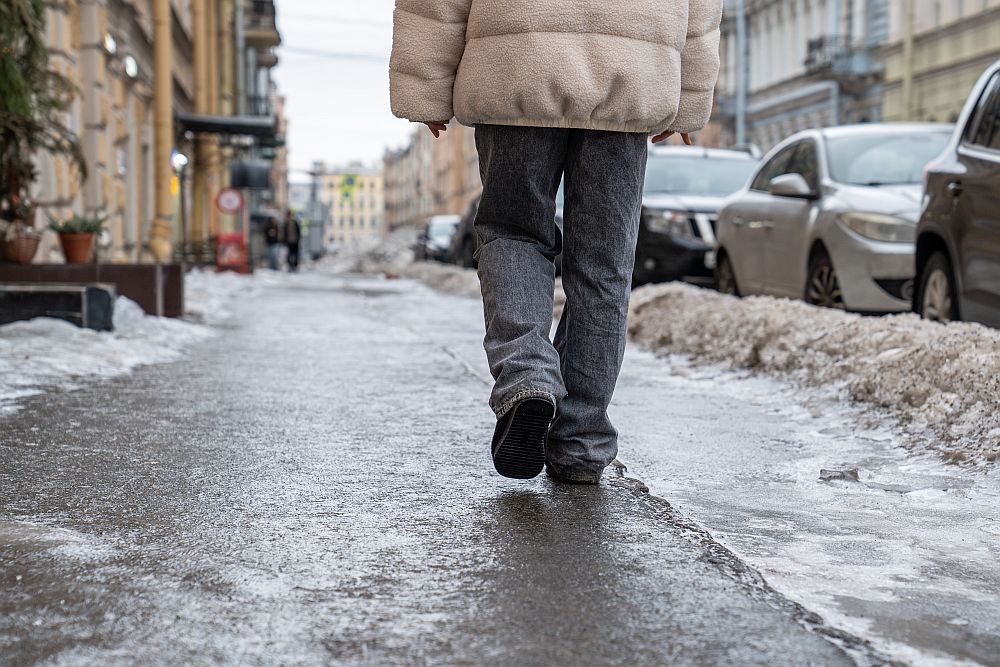
[Image above] Road salt is the most common de-icing method for thoroughfares, but self-heating concrete could be a more environmentally friendly and cost-effective alternative in the future. Credit: DimaBerlin, Shutterstock
With autumn approaching in the northern hemisphere, our thoughts turn to preparing for the coming colder temperatures. Among the tasks is confirming stores of road salt, which is used to help prevent ice formation on thoroughfares, have been replenished. But salt damages the infrastructure and the environment, so many are seeking alternative de-icing methods.
Among those alternatives are heated sidewalks and roadways. These systems work by embedding different types of heating elements into the pathways. For example, places with a lot of “free” thermal energy, be that from industrial processes (Holland, Mich.) or naturally (Iceland), may install pipes under the ground carrying heated fluid. On the other hand, some cities such as in Norway have embedded electric heating elements in their sidewalks and roadways.
Implementing these heating systems comes with several challenges, however. Most pressing among those are the installation and maintenance disruptions and costs. Existing infrastructure must be replaced to install such systems. And even where systems are installed during initial construction, repairs to the heating systems require reconstruction of the affected areas.
To avoid the challenges that come with embedded heating elements, researchers are also investigating self-heating concrete as a way to de-ice sidewalks and roadways. Self-heating concrete warms itself without the need for separate elements thanks to electrically conductive or thermally responsive materials contained within the composite. Because the heating capabilities are integrated into the concrete itself, maintenance disruptions and costs are reduced.
Electrically conductive materials are a main approach to creating self-heating concrete, and many groups are exploring adding various forms of carbon (such as graphite, fibers, and nanotubes) to enhance the composite’s conductivity. The challenge to this approach, though, is finding the right balance between conductivity and strength.
In a recent paper, researchers from Zhejiang University in China compared the effects of graphite and carbon fibers on the conductivity and strength of geopolymer composites. They added large amounts of graphite and small additions of carbon fiber (100 wt.% and 1 wt.% of metakaolin, respectively).
The addition of the two forms of carbon improved the electrical conductivity, though the relative effects are mixed. At low applied voltages, the carbon fibers appear to have a much stronger influence. But at higher voltages, the samples containing carbon fibers demonstrate faster performance degradation compared to graphite-containing samples.
Regarding thermal conductivity, graphite greatly improved this property while the addition of carbon fibers had a smaller effect. But on the other hand, graphite led to reduced strength while the carbon fibers did not. In fact, the samples with carbon fibers appeared to strengthen the samples.
In another recent paper, researchers from the University of Babylon in Iraq explored the electrical conductivity and strength of graphite/geopolymer composites. They added graphite at various proportions of up to 120 wt.% versus the metakaolin base material. They also varied the water content.
Adding water and graphite raised the electrical conductivity compared to the pure geopolymer. While conductivity clearly increased with increasing graphite content, the relationship between water content and conductivity was less clear.
Meanwhile, the strength of the geopolymer substantially decreased with carbon and water additions. While higher amounts of water led to weakened geopolymer, the relationship between amount of graphite and strength is not as clear.
Both sets of authors identified substantial electrical performance degradation over both long-term and cyclic operations. They cite interactions at the carbon–geopolymer and composite–electrode interfaces as potential causes. The former, they reasoned, is caused by water loss during cure and testing. The latter is caused by chemical reactions.
Because the authors of the former study aged the samples for only 7 days, the authors of the latter paper (who published their study 8 months later) reasoned that water loss should be much lower in highly aged systems and that interfacial reactions are more important. They tested these hypotheses by washing 28-day aged samples to remove free ions. Greater cyclic stability resulted.
With these findings, carbon–geopolymer composites show promise for self-heating construction materials. Combined with low-cost and environmentally friendly electricity generation, there is potential for improving the safety, maintenance costs, and environmental footprints of roadways and sidewalks in colder climates.
The first paper, published in International Journal of Applied Ceramic Technology, is “Electrothermal effect of carbon fiber and graphite reinforced metakaolin-based geopolymer” (DOI: 10.1111/ijac.14731).
The second paper, published in International Journal of Applied Ceramic Technology, is “Mechanical and electrothermal properties of lightweight graphite/geopolymer composites” (DOI: 10.1111/ijac.14981).
Author
Jonathon Foreman
CTT Categories
- Cement


